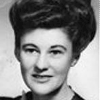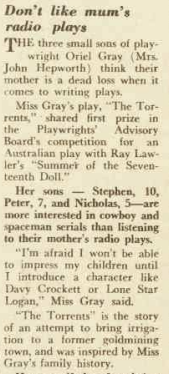AustLit
-
Merrilee Moss gives an account of Gray's social situation in terms of phenomenological spaces structured around 'the stranger'. According to Moss, Gray's role in Australian drama can be understood as that of the outsider who was 'expelled from the zone of Australian national theatre in order to keep the nation and the national identity safe' (34). To further examine this position of outsiderness, I will be drawing on the concepts of homeworld, borderzones, and liminality that Moss employs in her analysis.
-
It is perhaps tautological to state that if there is an alien, then the space within which the alien is defined is not home to the alien. Rather, it is home to those whose sense of belonging allows them to identify the alien as alien. The non-aliens, the insiders, then, lay claim to this space as the homeworld. The homeworld is established in opposition to an alienworld, and so brings about a 'co-constitution' of these worlds in relation to each other (Steinbock qtd. in Moss 35). Thus we can understand a nation in search of its national identity as one tracing out the scope of the homeworld – the social space within which the Australian may rest definitively inside – and in so doing enacting the exclusion of the alien in its midst.
-
Oriel Gray's place in the homeworld can be observed first at the intersection of being woman and writer. In discussing the lives of 1930s' women novelists, Drusilla Modjeska identifies the conflicts inherent to even the most practical consideration of a woman's duties as writer and duties as wife, mother, daughter, or poorly paid and long-labouring professional:
Writing, as any writer will tell you, takes time and long periods of contemplation. These do not come easily to women, unless they are among the privileged few with independent financial means. As it was, their experience as women frequently contradicted or clashed with their existence as writers. (11)
According to Modjeska, these 'mundane' issues are simply a pointer to the fundamental disparity between these women's social positions and the supposed 'culturally transcendent' existence of a writer (11). Michelle Arrow observes, however, that the absence of such transcendent beings from the Australian play-writing scene may have been precisely what allowed the entrance of women playwrights (44) – just as it was the budding of the Little Theatres in the absence of professional ones that gave space to learn and hone their art, as I will discuss in Production Spaces.
Secondly, since the constitution of Australia's identity was at that time (and perhaps still is) tied irrevocably to the wars, it is necessary to consider how the Second World War and post-War climate shaped Gray's relation to the homeworld. The most telling aspect of Australian woman playwrights' attitudes to the wars may be their variety: drastic social change was bred in the great diversity of women's involvement and their corresponding perspectives. As Susan Pfisterer and Carolyn Pickett recognise the broad sweep of women's experiences – as nurses in active service, as those who shored up their country at home and who participated in a revolution of working roles because of it, as those who waited, as those who healed the returning soldiers and themselves – they write:
...there is no single 'female' response to war – although it is curious to consider the prominence of peace plays and the lack of dramas which argue on behalf of the Empire or its concerns, for example. Instead, the response to war of these playwrights reveal the complexities of being a woman in times of heightened anxieties. (158-59)
Cacophonous in their variety and frequently dissonant in their content, these responses could not settle inside the stability of the homeworld. According to Pfisterer and Pickett, wartime plays, by the very nature of their engagement with audiences and newspapers, were frequently employed as a means of having a political voice. For Gray, certainly, with her long-standing involvement in the Communist Party of Australia (CPA) and the associated New Theatre, relation to the homeworld was as fraught by political outsiderness as by the conflict inherent to her status as playwright.
-
At the limit of the homeworld, at its intersection with the alienworld, is the borderzone: 'a place on the edge of privilege and the main community' (Moss 35). Gray did not belong to the alienworld; we can see that in the way that this article from Women's Weekly, for instance, lays claim to those aspects of her which fit inside the main community.
We can also see the way those aspects of Gray which are transgressive – her relationship with John Hepworth (who was not her husband), and even her status as prizewinning playwright – are pushed to the margins. Gray occupies a borderzone space, and Moss argues that it is precisely this location which 'provided Gray a particular understanding and a unique viewpoint' from which to critique colonial Australia (74). And, in addition to the influence of social borderzones on Gray's own viewpoint, I would argue that it is precisely the borderzone spaces of production and drama which so effectively staged her questioning of and negotiation with the hegemonic search for a national identity which had enraptured the nation and its theatre.
[The Australian Women's Weekly, 22 Feb 1956. Image sourced from Trove.]
-
The final spatial concept, closely connected with the borderzone, is liminal space. Moss adopts Arnold van Gennep's use of 'liminal' to describe the middle stage of a rite of passage: the transitory, intermediate space between aggregation within two social communities (36). Liminality thus contributes a sense of the temporal and the transitional to the marginal spaces of the borderzone. As one who lived the movement between the socially separated writer-worker and mother, and the transition into and out of an identity founded in the political views of the CPA, the liminal space is both familiar and integral to Gray's writing.
You might be interested in...





